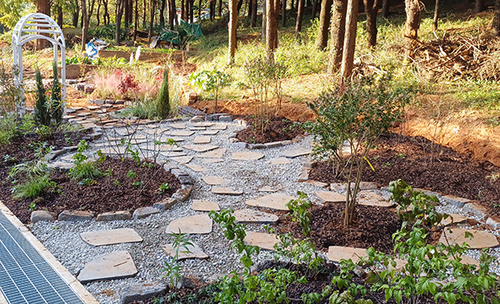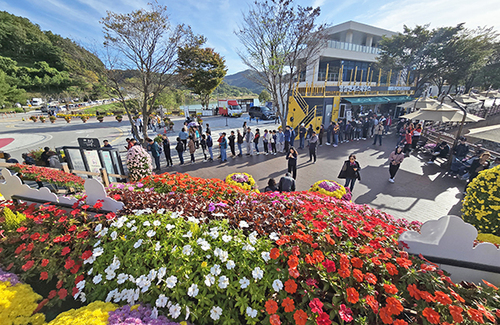| ▲ 전북 고창군 반암리에서 국내 초기 청자 도입과 전개과정을 밝힐 수 있는 '벽돌가마ㆍ진흙가마ㆍ건물지' 등이 중첩된 '아파트형 가마터'가 발견돼 학계에 관심이 모아지고 있는 가운데 유적 보존관리를 위해 道 지정 문화재(기념물)로 지정 예고됐다. / 사진제공 = 고창군청 © 김가영 기자 |
|
전북 고창군 반암리에서 국내 초기 청자 도입과 전개과정을 밝힐 수 있는 '벽돌가마ㆍ진흙가마ㆍ건물지' 등이 중첩된 '아파트형 가마터'가 발견돼 학계에 관심이 모아지고 있는 가운데 유적 보존관리를 위해 道 지정 문화재(기념물)로 지정 예고됐다.
'반암리 청자요지(盤岩里 靑瓷窯址)' 일원은 ▲ 용계리 청자요지(사적) ▲ 분청사기 요지(사적) ▲ 용산리 분청사기요지(道 기념물) 등 다수의 가마터가 밀집 분포하는 등 우리나라 도자 문화의 중심지로 인정받고 있다.
학계는 10세기 후반부터 오랫동안 운영됐고 대형 건물지까지 확인되면서 역사적ㆍ학술적 가치가 우수해 문화재청의 긴급 발굴조사 및 고창군이 주관한 학술발굴조사를 통해 우리나라 청자 도입과 변화과정을 엿볼 수 있는 초기 청자 가마터로 평가받았다.
12일 고창군은 "'반암리 청자요지(盤岩里 靑瓷窯址)'가 2021년 제10차 전라북도 문화재위원회 지정 심의결과 道 지정 문화재(기념물)로 지정 예고됐다"고 밝혔다.
유적은 현재까지 진행된 발굴조사 결과 ▲ 3기의 퇴적구릉 ▲ 벽돌가마 1기 ▲ 진흙가마 6기 ▲ 건물지 5기 ▲ 수혈 2기 등이 중첩돼 존재함이 밝혀졌다.
벽돌가마는 잔존상태가 양호하고 가마 길이는 40m 내외로 추정됐으며 너비는 2.7mㆍ바닥경사도는 10도 내외 규모와 3회 정도 개축해 운영했음이 확인됐다.
또, 벽돌가마(1호) 위로 중형의 진흙가마(2호)가 축조됐고 그 위쪽으로 소형의 진흙가마(3~5호)가 순차적으로 축조되는 아파트형 구조를 보였다.
가마는 길이(10~12m)와 너비(1.5~1.9m)ㆍ석재 화구(火口) 등 규모와 구조에서 모두 유사한 형태다.
이는 벽돌가마와 진흙가마가 순차적으로 축조돼 초기 청자가마의 변화과정을 규명할 수 있는 특징으로 우리나라 도자사 연구에 매우 중요한 유적으로 평가받았다.
건물지는 무려 31m에 이르는 대형 건물지가 확인됐으며 '◯坪ㆍ◯◯二月卄日ㆍ官◯車◯'등의 명문 기와 등이 출토돼 청자 생산을 관리하고 선별하는 관청으로 추정되고 있다.
유물은 해무리굽의 초기청자편과 갑발(匣鉢 = 불길과 재 등이 청자에 닿지 않도록 청자 위해 씌우기 위해 점토로 만든 그릇) 등이 출토됐다.
이 밖에도, 갑발 바닥과 옆면에서는 특수한 문양이 확인돼 주목되고 있다.
유기상 고창군수는 "'반암리 청자요지(盤岩里 靑瓷窯址)' 道 기념물 지정은 청자가마의 발생과 변화ㆍ생산 공정ㆍ관리체계까지 규명할 수 있는 중요한 유적으로 평가받아 용계리 청자요지와 함께 우리나라 초기청자 발생지이자 메카로 인정받은 것"이라며 "향후 유적의 보존관리와 함께 체계적인 발굴조사 등을 통해 국가지정문화재인 사적 승격을 위해 행정력을 모으겠다"고 말했다.
한편 '벽돌가마'는 고려 수도인 개경(開京) 중심의 중부지역에서 주로 확인됐으나 최근 진안 도통리에서도 조사돼 사적으로 지정됐다.
☞ 아래는 위 기사를 구글 번역이 번역한 영문의 '전문'이다.
【Below is the 'full text' of an English article translated from the above article with Google Translate.】
Notice of designation of 'Cheongjayoji' road monument in Banam-ri, Gochang
Apartment-type kilns with overlapping brick kilns, mud kilns, and building sites
Reporter Kim Ga-young
An 'apartment-type kiln site' was discovered in Banam-ri, Gochang-gun, Jeollabuk-do, where 'brick kilns, mud kilns, and building sites' overlapped with 'brick kilns, mud kilns, and building sites' that can reveal the process of introducing and developing early celadon in Korea. It has been designated as a cultural property (monument).
The area of 'Banam-ri Celadon Porcelain Yoji (盤岩里 靑瓷窯址)' is home to a large number of kiln sites such as ▲ Yonggye-ri Celadon Yoji (Historic Site) ▲ Buncheong Sagi Yoji (Historic Site) ▲ Yongsan-ri Buncheong Sagi Yoji (Do Monument), etc. It is recognized as the center of
The academic community has been operating for a long time since the late 10th century, and as large buildings have been identified, the historical and academic value is excellent. has been evaluated
On the 12th, Gochang-gun announced, "The 'Banam-ri cheongjayoji' was announced as a designated cultural property (monument) as a result of the 10th Jeollabuk-do Cultural Heritage Committee designation deliberation in 2021."
As a result of the excavation conducted so far, it was revealed that the remains were overlapped with ▲ 3 sedimentary hills ▲ 1 brick kiln ▲ 6 mud kilns ▲ 5 building sites ▲ 2 blood transfusions.
It was confirmed that the brick kiln was in good condition, and the kiln length was estimated to be around 40m, the width was 2.7m, the floor slope was about 10 degrees, and it was reconstructed and operated three times.
In addition, a medium-sized clay kiln (No. 2) was built above the brick kiln (No. 1), and small clay kilns (No. 3 to 5) were built sequentially above it, showing an apartment-type structure.
The kiln is similar in size and structure, including length (10~12m), width (1.5~1.9m), and a stone crater.
It was evaluated as a very important relic in the study of Korean ceramics because it is a feature that can identify the change process of the early celadon kilns as brick kilns and clay kilns were built sequentially.
A large building site of up to 31m has been identified, and prestigious tiles such as '◯坪·◯◯二月卄日·官◯車◯' have been excavated, and it is estimated that it is a government office that manages and selects celadon production.
Relics were excavated from the early celadon pieces of Haemuri-gup and the celadon (匣鉢 = a bowl made of clay to cover the celadon so that flames and ashes do not touch the celadon).
In addition, special patterns have been confirmed on the bottom and side of the gupbal, attracting attention.
Gochang-gun Mayor Yu-sang Yu-sang said, "The designation of 'Banam-ri Celadon Yoji (盤岩里 靑瓷窯址)' as a monument was evaluated as an important relic that can elucidate the origin and change of celadon kilns, production process and management system. It has been recognized as the birthplace of early celadon and Mecca," he said.
Meanwhile, the 'brick kiln' was mainly found in the central area of the center of Gaegyeong, the capital of Goryeo, but it was also recently investigated and designated as a historic site in Dotong-ri, Jinan.





















 많이 본 뉴스
많이 본 뉴스











